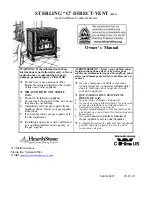
393691 LP GAS AND 394588 NATURAL GAS CONVERSION KITS
3
69-0244EF—01
Fig. 3. Proper flame adjustment.
Check and Adjust Gas Input and
Burner Ignition
CAUTION
Equipment Damage Hazard.
Exceeding input ratings can damage the
equipment.
1. Do not exceed input rating stamped on
appliance nameplate, or manufacturer
recommended burner orifice pressure for
size orifice(s) used. Make certain primary air
supply to main burner is properly adjusted
for complete combustion. Follow appliance
manufacturer instructions.
2. IF CHECKING GAS INPUT BY CLOCKING
GAS METER:
a. Make sure that the only gas flowing
through the meter is for the appliance being
checked.
b. Make certain that other appliances are
turned off with their pilot flames
extinguished (or deduct their gas
consumption from the meter reading).
c. Convert flow rate to Btuh as described in
form 70-2602, Gas Controls Handbook, and
compare to Btuh input rating on appliance
nameplate.
3. IF CHECKING GAS INPUT WITH
MANOMETER:
a. Be sure the gas control knob is in the
PILOT position before removing outlet
pressure tap plug to connect manometer
(pressure gauge).
b. Turn the gas control knob back to PILOT
when removing gauge and replacing plug.
c. Shut off gas supply at the appliance
service valve, or for LP gas, at the gas tank,
before removing the outlet pressure tap plug
and before disconnecting manometer and
replacing outlet pressure tap plug.
d. Perform Gas Leak Test at outlet pressure
tap plug.
Checking Gas Pressure Using a
Manometer (Pressure Gauge)
1.
Turn gas control knob to PILOT (standing pilot
systems) or OFF (intermittent and direct ignition
systems).
2.
Remove outlet pressure tap plug from gas con-
trol and connect pressure gauge. Refer to Fig. 1.
3.
Turn gas control knob to ON position.
4.
To obtain an accurate outlet pressure reading,
main burner must be cycled on and off several
times to stabilize the pressure regulator
diaphragm.
5.
Light main burner and read pressure gauge.
6.
If necessary, adjust pressure regulator to match
appliance rating. (On step-opening regulators,
match the full rate outlet pressure.)
a. Remove pressure regulator adjustment cap
screw.
b. Using a screwdriver, turn inner adjustment
screw clockwise
to increase or
counterclockwise
to decrease gas
pressure to main burner.
c. Always replace cap screw and tighten firmly
to prevent gas leakage.
7.
Turn gas control knob to PILOT (standing pilot
system) or OFF (intermittent and direct ignition
systems).
8.
Remove pressure gauge and replace outlet
pressure tap plug and pressure regulator cap
screw.
9.
Proceed to Checkout section.
Checking Gas Pressure Using
Meter Clocking Method
NOTE:
Use this method when manometer is not
available or when manifold pressure is not
specified in in. wc (kPa) by the burner
manufacturer.
1.
Make sure that the only gas flowing through the
meter is for the appliance being checked.
2.
Make certain that other appliances are turned
off with their pilot flames extinguished (or
deduct their gas consumption from the meter
reading).
3.
Turn gas control knob or switch to ON position.
4.
To obtain an accurate outlet pressure reading,
cycle main burner on and off several times to
stabilize the pressure regulator diaphragm.
5.
Using a watch with a second hand, carefully
clock the gas meter to determine the time per
revolution. Use Table 1 to determine the exact
main burner gas flow rate in cubic feet per hour
(cfh).
a. For one ft
3
per revolution gas meter dials,
use Table 1 directly.
b. For 1/2 ft
3
per revolution gas meter dials:
(1) Determine time for two dial revolutions
(2) Use Table 1 directly.
c. For two ft
3
per revolution gas meter dials:
(1) Determine time for one complete dial
revolution.
(2) Divide time by two.
(3) Use Table 1 directly.
6.
Compare actual input with burner manufacturer
recommended input (stamped on burner
nameplate). To convert Btuh rating to cfh
(m
3
/hr) use the following formula:
Input Rating in Btuh = (cfh) x (the BTU content of the gas)
7.
If necessary, adjust pressure regulator to match
appliance rating. (On step-opening regulators,
match the full rate outlet pressure.)
a. Remove pressure regulator adjustment cap
screw.
b. Using a screwdriver, turn inner adjustment
screw clockwise
to increase or
counterclockwise
to decrease gas
pressure to main burner.
c. Always replace cap screw and tighten firmly
to prevent gas leakage.
M3086B
PROPER FLAME
ADJUSTMENT
3/8 TO 1/2 IN.
(10 TO 13 MM)
THERMOCOUPLE


























